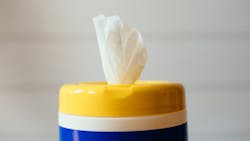Safety Technology: Moving Beyond Wipes for Sterilization
Personal protection equipment (PPE) shortages have been widely publicized and are of course critical to clinician and patient safety. And as headlines have shown, a lot of companies across a wide array of industries are stepping up to the plate to help alleviate the shortages by refocusing their production efforts to produce needed goods.
Shortages are also occurring with disinfectant chemicals and disinfectant wipes. “This means devices used on patients cannot be reliably disinfected and pose risk to all involved. SARS-CoV-2 appears to remain viable for on plastic and metal surfaces for 72 hours, and on glass for 96 hours,” says Sterifre Medical CEO Rick Shea. “Based on this, you can imagine the amount of contamination that is present in the healthcare environment. One AURA-D disinfectant cartridge can replace 22 canisters containing 165 disinfectant wipes each. In both the current environment and long term, this solves many of the manufacturing, environmental and logistics challenges hospitals face.”
Currently, hospitals are experiencing shortages of disinfectant wipes and are having difficulty with reliably securing these products. There are only a small number of specialty wipe manufacturers in the U.S., and only a handful of brands are approved by the EPA for coronavirus in the healthcare setting, making shortages more prevalent. EPA has fast-tracked approval of this tech and we expect it in the weeks ahead.
AURA uses a hydrogen peroxide micro-spray in a closed-loop continuous flow system. It is completely automated. Clinicians simply place devices inside, push a button, and walk away. This process uses a well-recognized hospital disinfectant, but typically had to be done in a centralized area of the hospital. AURA allows this to take place at the point of care.
Shea explains the premise for AURA was never based upon the COVID-19 pandemic. Sterifre Medical was preparing AURA for commercial launch prior to COVID-19. Existing device disinfection practices have many challenges including being manual as opposed to automated, ineffective unless directions are specifically followed (e.g. keeping devices wet for multiple minutes), damaging to devices, health risks for nurses due to repeated chemical exposure, and environmental issues considering that billions of wipes are thrown away each year with 100 years of decomposition time.
“Because we know that we can assist in this crisis, we have asked the EPA to expedite our approval,” he says. “Our technology resolves ongoing issues that have been faced by hospitals whose only choice is to use antiquated products and procedures like trying to regularly, manually wipe devices with disinfectant. It is time for an automated solution that protects our healthcare workers.”
About the Author
Peter Fretty
Managing Editor
As a highly experienced journalist, Peter Fretty regularly covers advances in manufacturing, information technology, and software. He has written thousands of feature articles, cover stories, and white papers for an assortment of trade journals, business publications, and consumer magazines.

